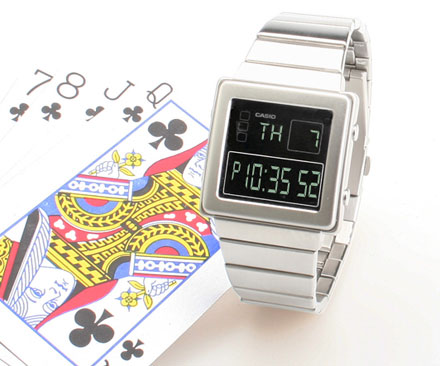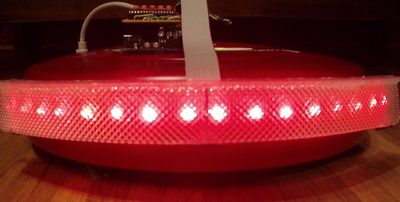Not quite using magic as a metaphor, but more traditional stage magic (i.e. a technological assist for what's a sleight of hand deception), Casio's magic watch assists in doing five different magic tricks. Stage magic and technology have a long history of supporting each other. The two movies about magicians this last fall, The Illusionist and The Prestige were, to some extent, about late 19th century society coming to terms with the burst of technology appearing on the scene. Some of the questions at the core of the characters lives (in The Prestige at least), are questions about reality and technology's ability to change it. And if films are like society's dreams, reflecting its concerns back to itself, but obliquely and in coded language, then these films reflect a current set of concerns about what technology is capable of, and what it's not. This watch, although a minor footnote at best, is part of that dialog, part of the grey area.
December 2006 Archives
I was pretty excited that Vauhini Vara of the Wall Street Journal asked me to talk to her about tired.com a couple of months back. I'm even more excited that the story was in the paper yesterday (subscription required) and is available syndicated online today.
Those who read Paul's piece in Slate a couple of years back will know the general outlines of the project, but Vauhini fills in details, updates it and presents a fresh analysis. I'm super flattered. Thank you, Vauhini!
While writing the last entry, I remembered a tongue-in-cheek myth from electrical engineering, documented in Wikipedia, which says that
there is a little bit of magic blue smoke in every integrated circuit, resistor, transistor, and all other electronic components and it is this smoke which makes the device work. The magic smoke is put in at the factory when the device is manufactured. High voltages or excessive current supposedly releases the smoke. [...] once the magic smoke has been released, the chip is lacking a key component and no longer works.
Without claiming that electrical engineers take this myth literally, it's a reminder of how easy it is to attribute magical properties to technology when there's no obvious mechanical functionality. Not even engineers can see moving electrons, and (I suspect) this "naive" gut-level explanation easily emerges, and regularly reappears. The joke pokes fun at how people who don't understand electronics think of how electronics works. It's funny, and it perpetuates, because it identifies an immediate reaction that everyone who has fried a component has probably had. The blue smoke is so startling, so physical (as opposed to electronic) and such a distinct marker that something is wrong that it's hard to not attribute some significance to it. If it's not magical, it sure feels that way, at least for a second.
My business partner in ThingM Tod continues to reach new heights in hacking Roombas. A couple of weeks ago, he built a custom circuit to give Roombas a Battlestar Galactica cylon eye...but just having moving LEDs wasn't enough, and he included a circuit that simulated the incandescent lights of the original costume. Then he stayed up all night making a parody of the new Battlestar Galactica credits.
Then, a couple of days ago, he figured out how to control Roombas using the MacBook's built-in tilt control (which has become a fascinating interface affordance in its own right).
Hacking robotic vacuum cleaners seems like a pastime--like building ships in bottles--and one of the common rhetorical questions that gets asked when these things get posted is "But why?" For me it's an important step in the developing a level of familiarity with technology and treating ubiquitous computing technologies as personal tools, rather than as mysterious "other" technology. One of the reasons why technology seems magical at first is its mysterious functionality: when it's unfamiliar, it's magical. I've argued before that magic may be valuable as a metaphor for explaining technology, but as many people have pointed out, technology is not magic and should not be presented as such literally.
I believe that part of using magic as a design metaphor should include a way to pull back the veil of the magic by familiarizing people with its actual functionality. The metaphor doesn't have to suffer--people will still understand that it's an analogy to magic, rather than a literally magical experience--but I believe it will help people position and use the technology to the fullest extent, but reducing the mystery. Showing that it's possible to hack everyday technology (especially technology that's designed to be hacked, like the Roomba) is akin to a magician explaining their tricks. The tricks aren't any less magical, but the process of revealing the actual working helps people understand themselves and their relationship to the world. That, of course, is the true brilliance of Penn and Teller's early work, which was about debunking the idea of magic, while still using magic. Hacking Roombas may not have the same impact as Penn and Teller's work, but it's a small step in clarifying the relationship between ubiquitous computing technology and people using it.
I wrote a short piece in the latest version of MAKE (the digital version will be available when the next version comes out). It documents an open source ball game that my friends at Platial were involved in creating. This is an actual outdoor game played with actual balls...nothing digital involved, other than the rules Wiki. Here's a sample of the piece:
They started playing standard kickball on the bocce court, but quickly had to modify the traditional rules. The bocce court was too small for there to be three bases, so they appropriated cricket's two-base system (but kept kickball's baseball-inspired system of strikes, outs and innings). From soccer, they borrowed the idea of throwing the ball back in when it goes out of bounds, and that led another important change. As Wilson says, "you can [really] bean somebody," when you throw a ball in the close quarters of the bocce court, so they introduced rules from dodgeball.Borrowing ideas and adapting the rules became part of playing the game. With spring, bocce season started and the courts were in use on the weekends, but the bank drive-through wasn't, so it became a legitimate court and the rules changed again to accommodate it. As Wilson puts it, "It was never declared that it was going to have a collaborative rulemaking process, but that's what it was."
The rest of the issue, which focuses on games and toys, is pretty entertaining. Get your copy at the newsstand.






Recent Comments